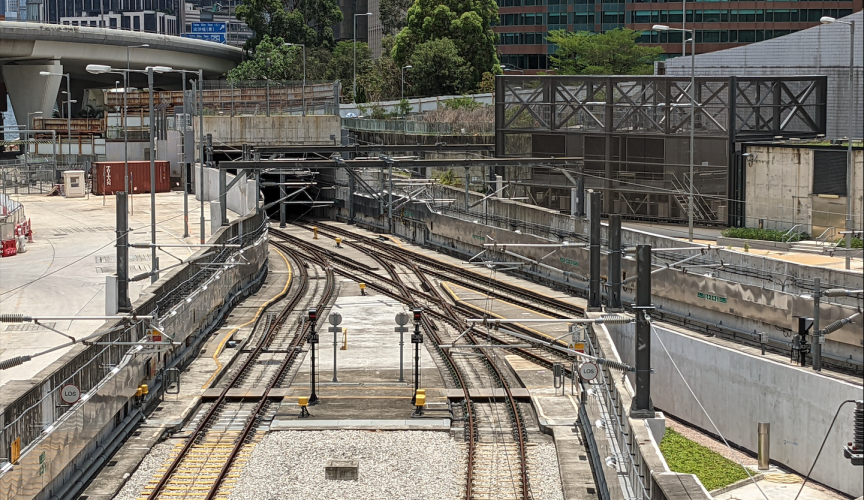The amount of rebars actually used in the construction work under Contract 1112 in the Shatin to Central Link project outweighed what was estimated in the contract by about 8,000 tonnes, from the Highways Department’s response following FactWire’s detailed inquiry on the matter.

The amount of rebars actually used in the construction work under Contract 1112 in the Shatin to Central Link project outweighed what was estimated in the contract by about 8,000 tonnes, from the Highways Department’s response following FactWire’s detailed inquiry on the matter.
According to the Highways Department, around 47,000 tonnes of rebars were used in the works under Contract 1112, yet only around 39,000 tonnes were projected to be used as specified in the original contract.
Concerning the same project, FactWire first reported in February an over-provision of couplers that doubled what was initially specified. A follow-up report was published by FactWire earlier this month as the Highways Department responded that, based on an assessment by a consultancy firm employed by the MTR, around 260,000 couplers were actually used. This was 44 percent more than what was initially estimated in the contract.
Read also:
Couplers ordered doubles the amount stated in Shatin-Central Link project contract
Using information from the subcontracts and the price of rebars at that time, FactWire estimates an extra cost of HKD 68 million incurred from purchasing these rebars and couplers, along with the cost of the work involved.
A consultancy firm was employed by the MTR to verify the actual use of materials in the project, for which the audit report was completed and submitted to the Highways Department in March this year. However, both the Highways Department and the MTR maintain that the report cannot be published due to confidentiality issues required by their contract.
The Highways Department confirmed that the discrepancies in coupler and rebar amounts are the most significant findings of the report in relation to construction materials. If any primary evidence shows the involvement of a criminal offence, the case would be referred to a law enforcement department.
‘Adjustment of such a kind in large-scale infrastructure constructions is not uncommon,’ said the Highways Department, explaining that it is due to the difference caused before and after construction design, and by the adjustment of details in work duration, materials, human resources, machineries, and construction methods. It is thus inappropriate to make comparisons only on the difference in material amounts before and after those adjustments, said the department.
The MTR also said it is ‘common practice in the construction industry’ to make adjustments in the amount of materials used depending on the changes in design, work procedures and methods, as well as the impact of temporary works or depletion.
However, it was mentioned in the final report by the Expert Adviser Team, previously appointed by the government to investigate the construction project, that it is uncommon to have a significant degree of over-provision of construction materials. In this case being discussed, it was found that the rebars used in the East West Corridor were in excess of what was required by the Code of Practice for Structural Use of Concrete. Such over-provision caused slabs to possess spare capacities of as much as 467 percent. The Expert Adviser Team thought the MTR’s intent for such an over-provision was unclear and the MTR could neither offer a reasonable explanation.

Based on the Highways Department’s response to FactWire’s detailed inquiry, around 47,000 tonnes of rebars were actually used, which is 8,000 tonnes or 20 percent more than the amount specified in the contract. As for couplers, around 260,000 were used, amounting to 80,000 more than that required by the contract.
With reference to a contract signed in May 2013 between the main contractor Leighton (Contractors) Asia Limited and the coupler supplier BOSA Technology (Hong Kong) Limited, each coupler costed HKD 95.2 on average, while a Bloomberg report in May 2013 shows that each tonne of rebar costed around HKD 4,328 at the time. Thus, the extra couplers and rebars used in the Shatin to Central Link project would have cost approximately HKD 42.24 million.
One of the subcontracts under Contract 1112 states that the work of installment cost HKD 2,850 per tonne of rebar and HKD 41 per coupler. Based on this, HKD 22.8 million and HKD 3.28 million would have been incurred from installing the extra rebars and couplers respectively. The costs of these extra materials and of the installment of them amount to roughly HKD 68.32 million.
The payment is still being calculated between the government, MTR and the main contractor Leighton, said the Highways Department. As of now, the MTR has not been notified to pay for any extra materials other than the amount specified in the original contract.
The MTR said that payment to its contractor would be made according to the ‘amount of materials appropriately used’.
Leighton was responsible for supplying the rebars, while the supply of couplers and threading of rebars were subcontracted to BOSA, as specified in the report by the Commission of Inquiry into the construction project.
According to the same report, Contract 1112 is a ‘target cost’ contract, meaning that the government and Leighton would share the additional costs when the actual cost is higher than the initial target, with the government’s exposure to additional costs capped at 10 percent of the initial target cost.
